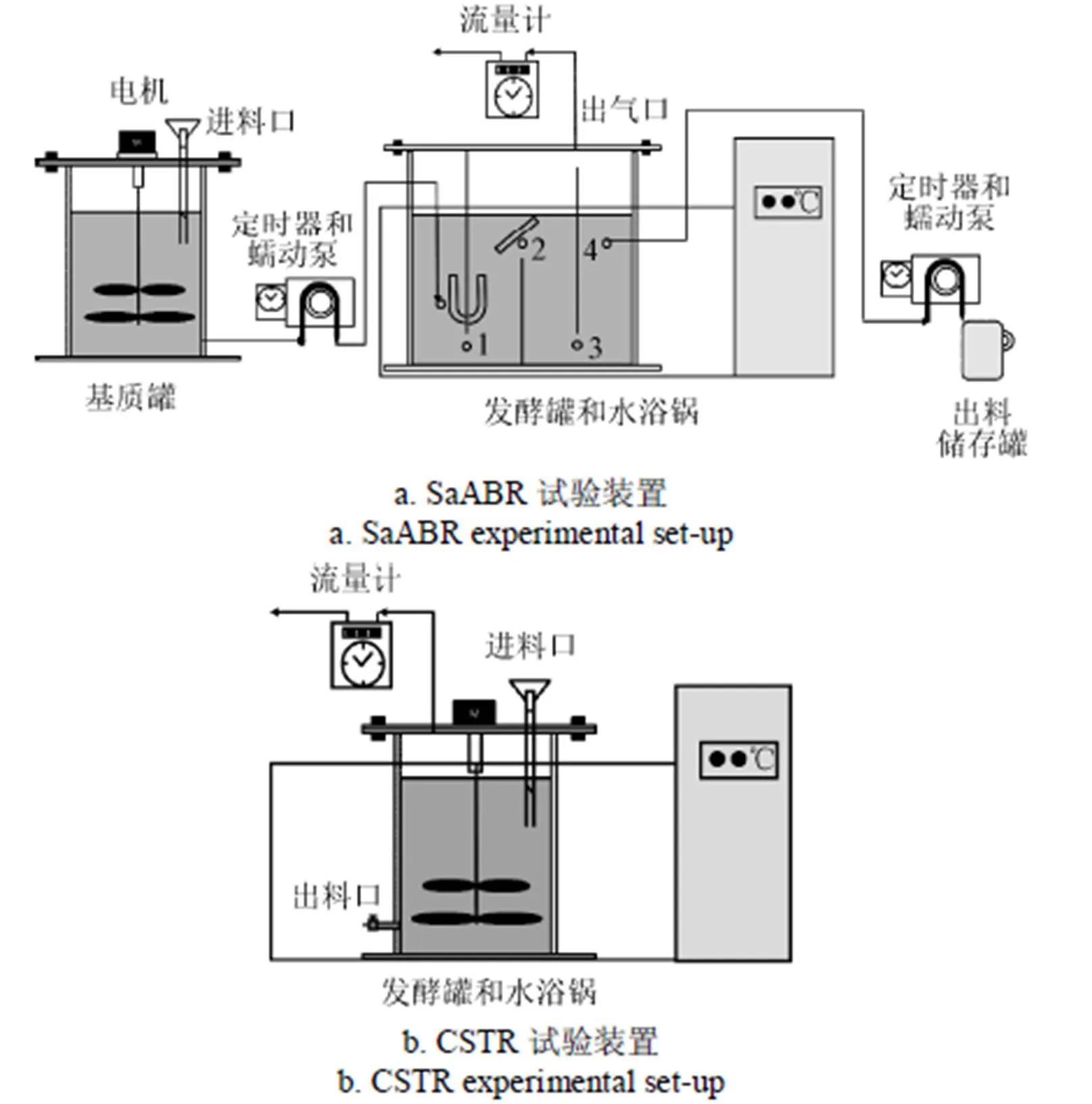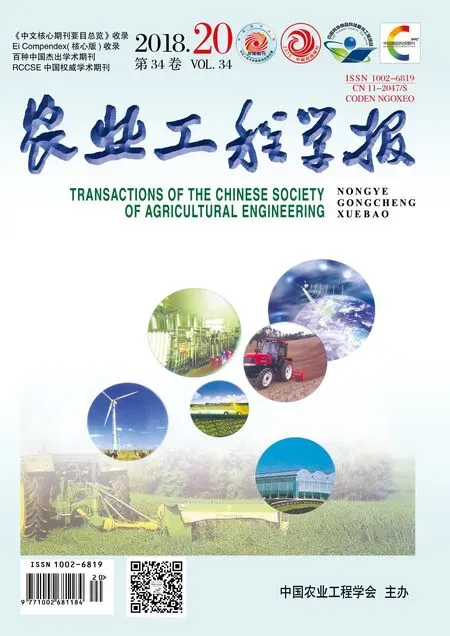自搅拌厌氧折流板反应器连续处理猪场废水的效果
乔 玮,任征然,李晨艳,熊林鹏,李玉友,董仁杰,4
自搅拌厌氧折流板反应器连续处理猪场废水的效果
乔 玮1,2,任征然1,2,李晨艳1,2,熊林鹏1,2,李玉友3,董仁杰1,2,4※
(1. 中国农业大学工学院,北京 100083; 2. 国家能源生物燃气高效制备及综合利用技术研发(试验)中心,北京 100083; 3. 日本东北大学土木与环境工程系环境保全研究室,仙台 980-8579; 4. 中国农业大学烟台研究院,烟台 264670)
该研究以猪场废水为处理对象,采用自搅拌厌氧折流板反应器(self-agitation anaerobic baffled reactor,SaABR)开展200 d的连续中温厌氧消化试验,考察在水力停留时间(hydraulic retention time,HRT)3、2、1和0.5 d梯度缩短的过程中,SaABR截留微生物的效果以及反应器的产气性能、稳定性和污泥比产甲烷活性(specific methanogenic activity,SMA)。同时,该研究还开展了全混式反应器(completely stirred tank reactor,CSTR)78 d的连续对比试验。试验发现,SaABR具有良好的截留微生物的作用,在HRT 3 d时SaABR第1至第4取样口污泥挥发性固体(volatile solid,VS)浓度分别为10.2、4.1、44.2和2.5 g/L,而CSTR污泥VS质量浓度仅为2.6 g/L。较高的微生物量显著提高了有机物的降解率并降低了出水的有机酸浓度。随着HRT的缩短,SaABR的降解率也呈现下降。在HRT 1 d时,SaABR的单位VS产甲烷率为0.43 L/g,即使在HRT 缩短到0.5 d时,仍然可实现稳定的发酵产气(单位VS产甲烷率为0.24 L/g),而CSTR反应器由于微生物洗出不能在HRT 1 d时连续产气。该研究的结果显示,SaABR反应器所具有截留微生物的良好特性,为养殖粪水的处理提供参考。
废水;发酵;厌氧折流板反应器;自搅拌
0 引 言
养猪业是中国养殖业中的重要产业之一,2016年全国肉猪出栏头数为68 502万头[1]。据统计,一个年出栏万头的规模化猪场年排泄粪尿量为400万t,若采用水冲清粪的方式,则猪场废水年排量达到550多万t[2]。猪场废水COD 质量浓度高达6.9~18.1 g/L[3-5],若不能有效处理,将会对环境造成严重的危害。厌氧消化处理猪场废水在降解有机物的同时产生沼气[6],是一种经济有效的废水处理方法。
在众多厌氧反应器中,厌氧折流板反应器(anaerobic baffled reactor,ABR)能够分离水解酸化和产甲烷阶段,反应器具有两相系统的优点,同时能够截留微生物,大幅度的缩短水力停留时间(HRT)[7]。然而,折流板反应器没有搅拌系统,反应器内微生物和有机物不能很好的混合接触,传质较差[8]。为强化反应器的混合和传质,研究者们在ABR内部设置可实现反应器气体循环的U型管,使反应器可以实现无动力搅拌[9-11]。这种自搅拌厌氧折流板反应器(self-agitation anaerobic baffled reactor,SaABR)已在餐厨垃圾的厌氧处理中被发现有良好的性能[12-13]。目前,关于SaABR在养殖废水的厌氧处理的研究还鲜有报道。
为此,本研究开展SaABR处理猪场粪水的连续试验,考察反应器连续运行下逐级缩短HRT下的性能。为研究SaABR截留微生物的作用,采用与全混式反应器(completely stirred tank reactor,CSTR)进行比较。本研究结果将为SaABR反应器处理养殖废水的研究和应用提供有意义的借鉴。
1 材料方法与试验设计
1.1 试验材料与装置
猪场废水取自北京市北郎中种猪场,取回后过40目筛去除大颗粒和树叶等杂质后备用;接种污泥取自该养殖场运行良好的猪粪中温厌氧发酵罐新鲜出料。猪场废水和接种污泥的基本性质如表1所示。
SaABR反应器结构由日本东北大学环境保全研究室设计,反应器的运行方案参考该试验室以往研究发表的论文[9-12]。试验装置如图1所示,图1a为SaABR装置系统,图1b为CSTR装置系统。SaABR系统主要包括基质罐和发酵罐两部分,发酵罐总容积16 L,有效容积10 L。SaABR从左至右设置有4个隔室,第1隔室和第2隔室之间设置1个U形管,第2隔室上部完全密封,产生的沼气储存在第1隔室并将第1隔室液面压低,当液面低于U形管底部时迅速完成一次搅拌;第2到第4隔室上方连通,产生的沼气可以直接排出后经气袋收集。该反应器设有4个取样口,从左到右为取样口1至取样口4(如图1a所示)。进、出料口与蠕动泵(申辰BT100N)连接,通过定时器每天自动进出料,HRT为5和3 d时每天进出料2次,HRT为2 d时每天进出料4次,HRT为1和0.5 d时每天进出料8次。CSTR总容积为3 L,有效容积为2 L,HRT为5和3 d时该反应器每天进出料1次,HRT为2 d时每天进出料2次,HRT为1 d时每天进出料4次。2个反应器浸置于(37±1)℃恒温水箱中。产生的沼气使用气袋收集。反应器启动期HRT均为5 d,反应器的运行方案如表2和表3所示。

表1 猪场废水与接种污泥的基本性质
注:TS:总固体;VS:挥发性固体;SS:悬浮固体;VSS:挥发性悬浮固体;TCOD:总化学需氧量;/:未检测。
Note: TS: Total solid; VS: Volatile solid; SS: Suspended solids; VSS: Volatile suspended solid; TCOD: Total chemical oxygen demand; /: No detect.

图1 SaABR和CSTR试验装置

表2 SaABR运行方案

表3 CSTR运行方案
1.2 指标测试方法
TS,VS,SS和VSS采用烘干法测定[14];COD采用重铬酸钾法[14];碱度采用滴定法[14];氨氮采用水杨酸-次氯酸盐光度法[15]。pH值采用玻璃电极(Orion 5-Star pH)pH计测定。VFAs采用岛津GC-2010Plus气相色谱仪测定,采用30 m ×0.25 mm ×0.25m 的毛细柱 Rtx-wax色谱柱和FID检测器,载气(氮气)分压为0.4 MPa,流速40 mL/min,氢气流速为20~30 mL/min,进样口、色谱柱和检测口温度分别为230、60和250 ℃。沼气成分(N2、CH4与CO2)采用岛津GC-8A气相色谱仪测定,色谱柱采用10 m×2 mm不锈钢的,载气(氢气)分压为0.38 MPa,流速为20~30 mL/min,进样口、色谱柱和检测口温度分别为120、50和120 ℃。每3 d取SaABR和CSTR反应器出料测试各项指标。沼气量采用湿式气体流量计(LML-1)测量。
1.3 污泥产甲烷活性测试
在反应器稳定运行3个HRT后,开始进行产甲烷活性试验(specific methanogenic activity,SMA)[16]。每个血清瓶中加入90 mL营养液[17]并置于水浴锅中预加热至37 ℃,然后向血清瓶中加入10 mL从SaABR各取样口取出的污泥;再向血清瓶中加入1 mL质量浓度为240 g/L的乙酸钠溶液,血清瓶中的乙酸质量浓度为2 000 mg/L。立即向血清瓶中充入氮气30 s排出空气,盖上硅胶塞,用铝盖密封。每组试验设置2个平行。根据产气量每1~3 d用玻璃注射器测沼气产量,并分析沼气成分。实际的SMA通过将线性甲烷积累速率的初始斜率除以血清瓶中加入的挥发性固体来计算[18]。
2 结果与讨论
2.1 反应器连续运行的产气性能
SaABR反应器的运行性能如图2和图3所示,CSTR反应器性能如图4所示。本试验的启动期较长,SaABR反应器在第40天时产气逐渐稳定至0.56 L/(L·d),随着HRT缩短容积产甲烷率逐渐升高,单位VS产气率逐渐降低(如图3所示)。在HRT为3和2 d时甲烷容积产气率分别为0.85和1.14 L/(L·d)。当HRT缩短至1和0.5 d时,甲烷容积产气率分别达到1.62和1.71 L/(L·d)。

图2 SaABR连续运行系统性能
如图3所示,SaABR在HRT由3 d缩短到0.5 d的过程中,单位VS的甲烷产率分别是0.69、0.58、0.43和0.24 L/g。随着HRT的缩短有机物降解率呈明显的降低。本研究启动HRT为5 d,没有测试更长HRT下的甲烷产率。有研究报道,折流板反应器处理TS质量浓度为50 g/L的猪粪在HRT为14 d时VS甲烷率产为0.59 L/g[19],与本研究HRT 3 d时的结果相近。

图3 SaABR不同HRT条件下产甲烷情况
据此推测,在中温条件下SaABR在较短的HRT下即可取得较好的有机降解效果。CSTR随着HRT由3 d缩短到2 d,容积产甲烷率从0.25 L/(L·d)提高至0.44 L/(L·d)。在HRT为1 d时CSTR产气不稳定,在运行了14 d后,反应器趋近于不产气。CSTR停止产气时pH值为7.51,VFAs质量浓度为2 022 mg/L,反应器未出现酸化现象。这个浓度的VFAs也不会对甲烷菌产生显著的抑制作用[20]。产甲烷菌的倍增期为25 h[21],倍增期为65 h[22]。有研究发现HRT短于1 d时,由于大部分产甲烷菌生长缓慢[23],反应器内微生物会被洗出而导致发酵失败[24]。据此推测HRT为1 d时CSTR内的微生物由于停留时间过短而被洗出,导致发酵失败。表4对本研究及关于猪粪厌氧发酵产气情况进行了对比。
文献报道的氨氮抑制浓度差异很大为1 700~14 000 g/L[25],大多数产甲烷菌最适pH值范围为6.5~8.2[26],碱度需要在1~5 g/L以下[26]。如图2e至g和f至h,本研究中SaABR出料氨氮质量浓度在474~1 158 mg/L之间波动,CSTR氨氮质量浓度在741~1 234 mg/L波动,没有达到文献中的抑制浓度。两反应器pH值均在7~8之间波动,在适合产甲烷菌生长范围内。两反应器碱度也在合适范围内,均具有一定的缓冲能力。

表4 本研究的结果与文献的对比
注:SPAG为悬浮颗粒附着生长反应器。
Note: SPAG is suspended particle-attached growth reactor.
2.2 HRT对有机酸变化的影响
如图2c,当HRT为3、2、1 d时,SaABR出液VFAs质量浓度分为143、195和388 mg/L。当HRT为0.5 d时VFAs质量浓度达到了1 610 mg/L。CSTR反应器中VFAs浓度在HRT为3、2和1 d时VFAs质量浓度分别为793、1370和2 022 mg/L(图4c)。图5为HTR 3 d时SaABR各取样口和CSTR出料污泥的VFAs和TS质量浓度。SaABR反应器从第1至第4取样口取样测得VFAs质量浓度分别为375、327、64和70 mg/L。SaABR反应器内污泥大部分被截留在第3隔室,第3取样口污泥TS质量浓度最高为86.2 g/L,VFAs质量浓度最低。CSTR污泥TS质量浓度仅为5.4 g/L,VFAs质量浓度为786 mg/L。

图5 HRT 3 d时SaABR和CSTR内VFAs和TS质量浓度
有研究报道,采用SaABR反应器处理TS质量浓度为99 g/L的餐厨垃圾时,HRT为15 d时取样测试前3隔室VFAs质量浓度逐渐从1 156 mg/L逐渐降低到708 mg/L,第三隔室底部VFAs质量浓度降低至239 mg/L[12],与本研究变化趋势相近。
2.3 SaABR和CSTR污泥浓度分布和污泥活性
图6a至6e别为不同HRT条件下,SaABR反应器内各取样口污泥TS和VS浓度,图6f为CSTR反应器不同HRT条件下出料污泥TS和VS浓度以及VS去除率。SaABR反应器的取样口如图1a所示。SaABR反应器内污泥分布不均匀。随着HRT缩短,SaABR下部2个取样口(第1和第3取样口)污泥的浓度呈现降低的趋势,上部2个取样口(第2和第4取样口)污泥的浓度呈现上升的趋势。HRT为5、3、2、1和0.5 d时SaABR污泥的TS平均质量浓度分别为34.1、30.1、27.2、23.6和19.7 g/L。这说明HRT的缩短降低了SaABR截留微生物的能力。CSTR反应器的VS去除率随着HRT缩短逐渐降低,HRT为5、3和2 d时VS去除率分别为49.4%、35.7%和33.7%。HRT为1 d时,试验进行14 d后,CSTR进出料的浓度基本相同,说明微生物被洗出,已经没有微生物降解作用。SaABR相比于CSTR可以有效的截留微生物。
表5为HRT 3 d时SaABR各取样口污泥在乙酸浓度为2 000 mg/L时的产甲烷活性。SaABR 4个取样口的污泥SMA分别为116、97、44和85 mL/(g·d)。由于第3取样口污泥VS浓度较高,为44.2 g/L,大量微生物被截留在第3取样口,但可提供其降解的VFAs有限,所以其SMA最低仅为44 mL/(g·d)。

图6 SAABR和CSTR反应器内污泥TS和VS浓度

表5 HRT 3 d污泥产甲烷活性对比
3 结 论
SaABR具有良好的微生物截留能力,污泥主要分布在第3和第4隔室之间。SaABR在较短HRT条件下有较高的产气率,HRT 0.5 d时SaABR仍可以正常产气,单位VS产甲烷率为0.24 L/g,而CSTR在HRT 1 d时由于微生物被洗出而停止产气。随着HRT缩短,SaABR内污泥浓度逐渐降低,同时有机物降解率逐渐降低,出水VFAs质量浓度增加。本研究的结果显示,SaABR反应器处理猪场废水可以在较短HRT条件下取得良好的运行效果。
[1] 国家统计局. 中国统计年鉴[J]. 北京:中国统计出版社,2017.
[2] 王景成,杨秋凤,周佳萍,等. 利用沼气工程实现规模养猪业可持续、循环发展[J]. 饲料工业,2010,31(11):52-55.
[3] 王阳. UASB处理猪场废水启动试验研究[J]. 气象与环境学报,2007,23(2):34-37. Wang Yang. Start-up experiment on pig manure wastewater treatment in UASB reactor[J]. Journal of Meteorology and Environment, 2007, 23(2): 34-37. (in Chinese with English abstract)
[4] Sánchez E, Borja R, Travieso L, et al. Effect of influent substrate concentration and hydraulic retention time on the performance of down-flow anaerobic fixed bed reactors treating piggery wastewater in a tropical climate[J]. Process Biochemistry, 2005, 40(2): 817-829.
[5] Rodrigues L D S, Pinto A C A, Dutra J D C F, et al. Swine wastewater treatment using an anaerobic baffled (ARB) and a UASB reactor system[J]. Semina Ciencias Agrarias, 2017, 38(6): 3705.
[6] Sánchez E, Milán Z, Borja R, et al. Piggery waste treatment by anaerobic digestion and nutrient removal by ionic exchange[J]. Resources Conservation & Recycling, 1995, 15(3/4): 235-244.
[7] 周磊,陈朱蕾,廖波,等. 厌氧折流板反应器性能研究进展[J]. 工业水处理,2005,25(6):1-5. Zhou Lei, Chen Zhulei, Liao Bo, et al. Development of the performance researches on the anaerobic baffled reactor[J]. Industrial Water Treatment, 2005, 25(6): 1-5. (in Chinese with English abstract)
[8] Barber W P, Stuckey D C. The use of the anaerobic baffled reactor (ABR) for wastewater treatment: A review[J]. Water Research, 1999, 33(7): 1559-1578.
[9] Qi W K, Hojo T, Li Y Y. Hydraulic characteristics simulation of an innovative self-agitation anaerobic baffled reactor (SaABR)[J]. Bioresour Technol, 2013, 136(3): 94-101.
[10] Qi W K, Li W C, Du J R, et al. Simulation and configuration correlation analysis of the self-agitation anaerobic baffled reactor for treating livestock organic waste[J]. Biochemical Engineering Journal, 2015, 103: 85-92.
[11] Qi W K, Guo Y L, Xue M, et al. Effect of viscosity on the mixing efficiency in a self-agitation anaerobic baffled reactor [J]. Bioprocess & Biosystems Engineering, 2015, 38(5): 905-910.
[12] Kobayashi T, Li Y Y. Performance and characterization of a newly developed self-agitated anaerobic reactor with biological desulfurization[J]. Bioresource Technology, 2011, 102(10): 5580.
[13] 高希釈生ごみを対象とした担体設置型サイフォン撹拌式リアクターの高温メタン発酵特性)[J]. 土木学会論文集G(環境),2017,73(1):11-19.
[14] 贺延龄. 废水的厌氧生物处理[M]. 北京:中国轻工业出版社,1998.
[15] 国家环境保护总局《水和废水监测分析方法》编委会. 水和废水监测分析方法[M]. 第四版. 北京:中国环境科学出版社,2002.
[16] Wandera S M, Qiao W, Algapani D E, et al. Searching for possibilities to improve the performance of full scale agricultural biogas plants[J]. Renewable Energy, 2018, 116:720-727.
[17] Angelidaki I, Petersen S P, Ahring B K. Effects of lipids on thermophilic anaerobic digestion and reduction of lipid inhibition upon addition of bentonite[J]. Applied Microbiology & Biotechnology, 1990, 33(4): 469-472.
[18] Ahring B K. Methanogenesis in thermophilic biogas reactors[J]. Antonie Van Leeuwenhoek, 1995, 67(1): 91-102.
[19] Boopathy R. Biological treatment of swine waste using anaerobic baffled reactors[J]. Bioresource Technology, 1998, 64(1): 1-6.
[20] 张万钦. 微量元素添加对餐厨垃圾和鸡粪厌氧消化性能的调控研究[D]. 北京:中国农业大学,2016. Zhang Wanqin. Effect of Elements Addition on the Anaerobic Digestion Performance of Food Waste and Chicken Manure[D]. Beijing: China Agricultural University, 2016. (in Chinese with English abstract)
[21] Bock A K, Prieger-Kraft A, Schönheit P. Pyruvate: A novel substrate for growth and methane formation in Methanosarcina barkeri[J]. Archives of Microbiology, 1994, 161(1): 33-46.
[22] Patel G, Sprott G. Methanosaeta concilii gen nov. sp. nov. (Methanothrix concilii) and Methanosaeta thermoacetophila nom. rev. comb. nov[J]. International Journal of Systematic Bacteriology, 1990, 40(1): 79-82.
[23] 公维佳,李文哲,刘建禹. 厌氧消化中的产甲烷菌研究进展[J]. 东北农业大学学报,2006,37(6):838-841. Gong Weijia, Li Wenzhe, Liu Jianyu. Progress of research on methanogens bacteria in anaerobic digestion[J]. Journal of Northeast Agricultural University, 2006, 37(6): 838-841. (in Chinese with English abstract)
[24] Hill D T, Bolte J P. Methane production from low solid concentration liquid swine waste using conventional anaerobic fermentation[J]. Bioresource Technology, 2000, 74(3): 241-247.
[25] Chen Y, Cheng J J, Creamer K S. Inhibition of anaerobic digestion process: A review[J]. Bioresour Technol, 2008, 99(10): 4044-4064. (in Chinese with English abstract)
[26] 野池达野. 甲烷发酵[M]. 北京:化学工业出版社,2014.
[27] Hansen K H, Angelidaki I, Ahring B K. Improving thermophilic anaerobic digestion of swine manure[J]. Wat Res, 1999, 33(8): 1805-1810.
[28] 彭朝晖,樊战辉,孙家宾,等. 搅拌时间和顶空低压对猪粪产甲烷速率的影响[J]. 中国沼气,2017,35(6):50-55. Peng Zhaohui, Fan Zhanhui, Sun Jiabin, et al. Effect of stirring duration and digester low headspace pressure on methane production rate of swine manure[J]. China Biogas, 2017, 35(6): 50-55. (in Chinese with English abstract)
[29] Hill D T, Bolte J P. Evaluation of suspended particle attached growth fermenters treating liquid swine waste[J]. Transactions of the ASAE, 1986, 29(6): 1733-1738.
Continuous anaerobic treatment of swine wastewater by using self-agitation anaerobic baffled reactor
Qiao Wei1,2, Ren Zhengran1,2, Li Chenyan1,2, Xiong Linpeng1,2, Li Yuyou3, Dong Renjie1,2,4※
(1.100083; 2.,,(),100083; 3.,,980-8579; 4.,264670)
With the development of pig industry in China, environmental pollution from such development has become more and more serious. One of the most important problems of pig breeding is the wastewater treatment. Swine wastewater is characterized by the high concentrations of organic matters. Anaerobic digestion has been regarded as a promising technology for swine wastewater treatment to remove the high-concentration organic materials. At the same time, renewable energy in the form of biogas was produced through anaerobic degradation. Previous studies have reported that anaerobic baffled reactor (ABR) can achieve good performance in treating swine wastewater. However, due to the absence of agitation system, the mass transfer is an ABR is unsatisfactory. In order to improve the performance of an ABR, the self-agitation anaerobic baffled reactor (SaABR) was proposed. In the SaABR, a U tube was assembled inside the reactor. SaABR is previously studied in the anaerobic treatment. However, fewer its application in treating swine wastewater was found. The current study therefore investigated the performance of a long term operated SaABR in treating swine wastewater. The total and working volume of SaABR in this study were 16 and 10 L, respectively. Anaerobic treatment of swine wastewater for a period of 200-day was continuously conducted. Mesophilic condition was maintained at 37 ℃ while hydraulic retention time (HRT) was gradual shortening from 5, 3, 2, 1, to 0.5 days. The effects of HRT on the biomass retaining, biogas gas production, process stability, and specific methanogenic activity (SMA) was investigated. At the same time, in this study, we also conducted a 78-day continuous experiment by using a parallel continuous stirred tank reactor (CSTR) as control test. The results derived from this study indicated that SaABR significantly retained high biomass concentration. At the HRT 3 d period, the volatile solid (VS) concentration of the first to fourth sampling ports of SaABR was 10.2, 4.1, 44.2 and 2.5 g/L, respectively. The concentration of VS in the CSTR was as low as 2.6 g/L. The higher microbial biomass significantly increased the degradation efficiencies of organic and reduced the VFAs concentration of SaABR effluent. The degradation efficiency of SaABR also decreased with the shortening of HRT. The specific methane yield of the SaABR was 0.43 L/g at the HRT 1 d period. At the HRT 0.5d period stable biogas production can still be achieved. Through the long term experiment, an increase of volumetric gas production rate was observed: 0.85, 1.14, 1.62 and 1.71 L/(L·d) at HRTs 3, 2, 1 and 0.5 days, respectively. Specific methane gas yield decreased from 0.69 to 0.24 L/g when HRT was reduced from 3 to 0.5 d. These values were slightly higher than results of a previous study using ABR treating swine manure at 40 ℃, which reported specific methane yield was 0.59 L/g. The CSTR ceased to produce biogas at HRT 1 d due to the washout of biomass. At HRT 3 d period, the sludge SMA from the first to the fourth sampling port were 116, 97, 44 and 85 mL/(g·d), respectively. Conclusively, the results obtained in this study showed that SaABR had the advantages of retaining high biomass and would be a promising technology for the anaerobic treatment of swine wastewater.
wastewater; fermentation; anaerobic baffled reactor; self-agitation
10.11975/j.issn.1002-6819.2018.20.027
X712
A
1002-6819(2018)-20-0210-06
2010-04-26
2018-08-17
“十三五”国家重点研发计划课题(2016YFD0501403)、北京市自然科学基金(6182017)和北京市科技计划课题(D1611000016003;D1611000016001)
乔 玮,副教授,博士,博士生导师,主要从事废水和废弃物的厌氧生物处理研究。Email:qiaowei@cau.edu.cn
董仁杰,教授,博士,博士生导师,主要从事生物质能源与环境保护方面研究。Email:rjdong@cau.edu.cn
乔 玮,任征然,李晨艳,熊林鹏,李玉友,董仁杰. 自搅拌厌氧折流板反应器连续处理猪场废水的效果[J]. 农业工程学报,2018,34(20):210-215. doi:10.11975/j.issn.1002-6819.2018.20.027 http://www.tcsae.org
Qiao Wei, Ren Zhengran, Li Chenyan, Xiong Linpeng, Li Yuyou, Dong Renjie. Continuous anaerobic treatment of swine wastewater by using self-agitation anaerobic baffled reactor[J]. Transactions of the Chinese Society of Agricultural Engineering (Transactions of the CSAE), 2018, 34(20): 210-215. (in Chinese with English abstract) doi:10.11975/j.issn.1002-6819.2018.20.027 http://www.tcsae.org

